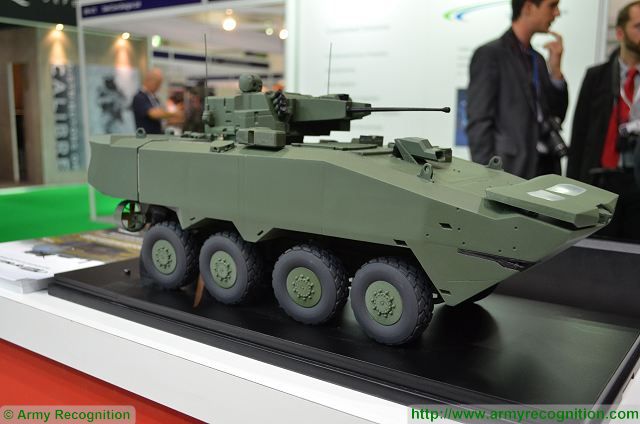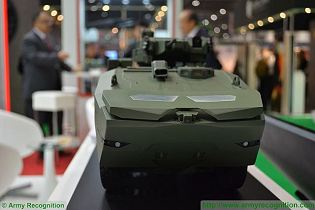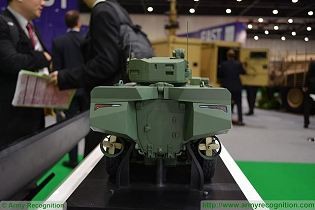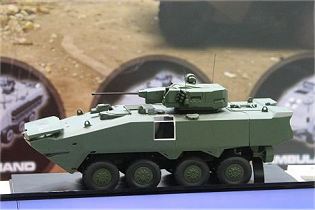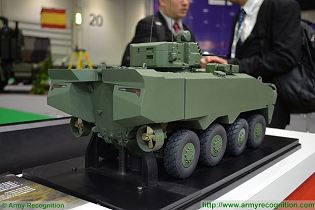|
The Terrex 2 is an improved variant of the Terrex 1 8x8 armoured vehicle personnel carrier designed and manufactured by ST Kinetics of Singapore. The Terrex 2 was unveiled for the first time at DSEI, the International Defense Exhibition in September 2015. The Terrex 2 is specially designed for littoral missions, allowing infantry forces to transit from land to sea and from coast to coast smoothly and safely. The Terrex 2 is also offered for the U.S. Marines Amphibious Combat Vehicle (ACV) program. The chassis of Terrex 2 is used for the Sentinel II armoured which is one of the candidates for the Australian Lan 400 Phase 2 program. The Terrex 2 is a cutting-edge 8x8 wheeled armoured vehicle with superior mobility, protection and network centricity that enhances the capabilities of global armed forces to fight as a mobile, networked force.
|
| Armament |
|
The Terrex 2 can be armed with a full range of weapon systems including roof-mounted remote weapon station armed with a 12.7 mm heavy machinegun or a co-axial 7.62 mm machine gun and 40 mm automatic grenade launcher. The roof is able to receive heavy turret armed with 30mm automatic cannon. Other systems can be fitted on the vehicle as anti-tank guided missile launchers, remote weapon stations or 120mm SRAMS mortar carriage according on customer requirements.
|
| Design and protection |
|
The hull of the Terrex 2 is of all-welded steel armour construction to which an additional layer of passive armour can be added for a higher level of battlefield survivability. The crew survivability of the Terrex 2 is enhanced with a proprietary hull design that it calls "V-over-V" (VoV), comprising two V-shaped hull sections: a lower section that is given over to the drivetrain and suspension systems; and an upper section that contains the protected crew and troop compartments. The lower section is designed to absorb the initial blast from a mine or improvised explosive device (IED), with the second V-shaped hull further reducing the likelihood of troop casualties. The driver is seated at the front of the vehicle on the left side with the power pack to his right. The Terrex 2 incorporates a larger, newly designed hull that focuses on troop survivability, increased payload capacity, as well as a high level of amphibious swimming capability. The payload of the vehicle is increased compared to the Terrex 1 offering increased payload capacity for weapons, armour, and expendables. The vehicle has a gross weight of 30,000 kg and can carry a total of 14 military personnel including driver and commander. The driver is seated at the front of the vehicle on the left side with the power pack to his right. In its baseline troop carrier version it has a crew of two and can carry up to 12 fully equipped troops. There is a large power-operated ramp at the rear of the hull which is also provided with a small manual door.
|
| Mobility |
|
The Terrex 2 is motorized with a six-cylinder Caterpillar C9.3 turbocharged diesel engine that generates 600 hp coupled to an automatic transmission Allison 4500 SP wide ration gearbox with 6 forward and 1 reverses gears. The Terrex 2 uses an 8x8 independent suspension double wishbones system to improve ground mobility and ride quality over the roughest terrain. The Terrex 2 is able to run at a maximum speed of 90 km/h with a maximum cruising range of 600 km. The Terrex 2 is able of accelerating from 0-50 km/h in less than 15 seconds. The vehicle is able to negotiate gradient up to 60%, side slopes to 30% and natural and engineered trenches of 2 m maximum.
|
| Accessories |
|
Standard equipment of the Terrex 2 includes NBC protection system. The Central Tire Inflation System enables automated inflation and deflation of tires to accommodate different terrain while on the move. In water, hydraulically driven propulsion systems with full independent thrust control authority to safely operate at Sea-State 3 and through six-foot plunging surf. The Terrex 2 is fully amphibious, being propelled in the water by two hydraulically driven and steered water jets mounted one either side of the hull at the rear. Before entering the water a trim vane is erected at the front of the vehicle. The hydrodynamic hull design, combined with a raised snorkel system and a refined propulsion system, has enabled the vehicle to achieve swimming speeds of up to 6 kt in water conditions as high as Sea State 4 in actual sea trials. In addition, a raised snorkel system allows the vehicle to "breathe" both on land and in water: the intake and exhaust tubes, located on the bonnet to channel airflow into and out of the vehicle, can be raised when the Terrex 2 is in water. This way, airflow is not disrupted by the change in the environment. The Terrex 2 is also equipped with the same suite of driving and situational awareness aids that feature on the current vehicle, including a camera array comprising 11 low-lux daylight and thermal imaging (TI) cameras mounted around its hull that supports closed hatch driving maneuvers and an omnidirectional surveillance system. However, ST Kinetics has developed a new hybrid imager - called the TI fusion camera - that combines the capabilities of the daylight and thermal imaging camera to present thermal signatures that are visible even on daylight color feeds. Unlike the Terrex 1, the Terrex 2 boasts an updated touchscreen dashboard, with two screens added below the three located at eye-level. These screens can be customized to display details such as the vehicle’s dashboard and gauges. They can also display data from system tests and reflect breakdowns and errors. The display can be moved from screen to screen to suit operational needs.
|
| |
| Specifications |
| Back to top |
|
Armament
|
|
One 7.62mm or 12.7mm machine. Turret with 30mm automatic cannon
|
|
Country users
|
|
Prototype - Tril test vehicle
|
|
Designer Country
|
|
Singapore
|
|
Accessories
|
| Central Tire Inflation System, NBC protection system, touchscreen dashboard, day/night vision system, thermal cameras |
|
Crew
|
| 2 + 12 |
|
|
Armor
|
|
Standard welded steel armour and V-shaped hull protection against mine explosion.
|
|
Weight
|
|
30,000 kg maximum
|
|
Speed
|
|
90 km/h on road 11 km/h on water
|
|
Range
|
|
600 km
a
a
|
|
Dimensions
|
|
Length: 8.0 m; Width: 3.6 m; Height: 2.8 m
|
|
|
|
| |
|
